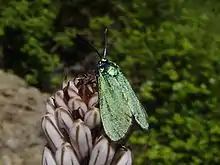Jordanita globulariae
Jordanita globulariae, also known as the scarce forester, is a day-flying moth of the family Zygaenidae.
| Scarce forester | |
|---|---|
 | |
 | |
| Scientific classification | |
| Kingdom: | Animalia |
| Phylum: | Arthropoda |
| Class: | Insecta |
| Order: | Lepidoptera |
| Family: | Zygaenidae |
| Genus: | Jordanita |
| Species: | J. globulariae |
| Binomial name | |
| Jordanita globulariae (Hübner, 1793) | |
| Synonyms | |
| |
Distribution
It is found from the western part of the Iberian Peninsula through western, central and eastern Europe to the Ural. In the south, the range extends through the Balkan Peninsula to north-western Turkey.[1]
Description
The length of the forewings is 10.5–17 mm for males and 7.7–10.1 mm for females.[1] Like the cistus forester, the adult moth is iridescent blue green with dark legs and antennae. It is found on sunny days flying in chalk or limestone grassland.[2]
The larvae feed on Centaurea (knapweed) species, Cirsium tuberosum (tuberous thistle) and Globularia species.
References
- C. M. Naumann, W. G. Tremewan: The Western Palaearctic Zygaenidae. Apollo Books, Stenstrup 1999, ISBN 87-88757-15-3
- Manley, Chris (2008). British Moths and Butterflies. Bloomsbury. p. 100.
External links
This article is issued from Wikipedia. The text is licensed under Creative Commons - Attribution - Sharealike. Additional terms may apply for the media files.